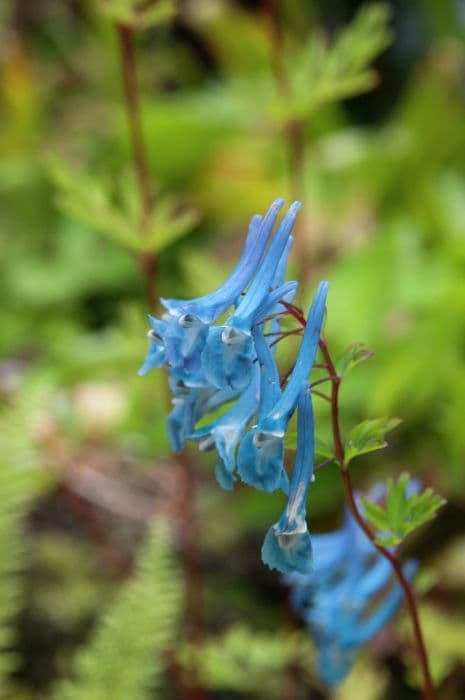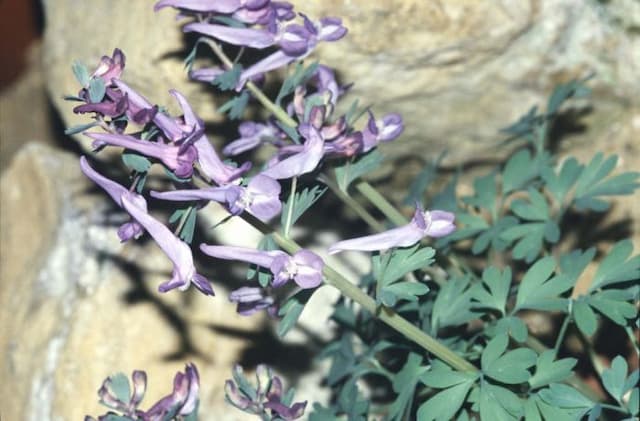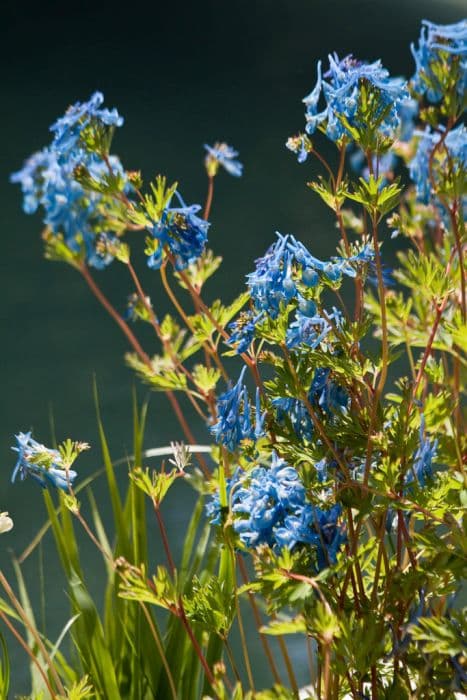Climbing Bleeding Heart Dactylicapnos scandens

ABOUT
The plant commonly referred to as "climbing bleeding heart" is a visually captivating species with distinctive features. It is adorned with delicate, compound leaves that are finely divided, giving them a fern-like appearance. The foliage lends a soft, lacy texture to the appearance of the plant and is typically a rich green color, which provides a striking backdrop for its flowers. The blooms of the climbing bleeding heart are its most remarkable attribute. They dangle elegantly from slender stems, resembling small, heart-shaped pendants. The flowers are usually a vibrant yellow color and may have subtle reddish or purplish shading at the edges, enhancing their ornamental appeal. Each flower has a tubular shape with a flared mouth, which gives it a unique, lantern-like appearance. This plant possesses a climbing habit, using tendrils or twining stems to cling and ascend, which allows it to intertwine with supports or other vegetation. As a climber, it can cover structures or grow over other plants, creating a tapestry of green foliage and punctuated with its characteristic yellow flowers. The overall impression is one of graceful draping and cascading beauty, which makes the climbing bleeding heart a sought-after plant for decorative purposes in gardens and landscapes.
About this plant
 Names
NamesFamily
Papaveraceae
Synonyms
Climbing Bleeding Heart, Dicentra Scandens, Golden Tears, Fern-leaf Bleeding Heart
Common names
Dicentra scandens, Dactylicapnos scandens var. grandifoliolata.
 Toxicity
ToxicityTo humans
The plant Dactylicapnos scandens, commonly known as the climbing bleeding heart, is not widely recognized for its toxicity to humans. However, it is always advisable to exercise caution with any plant. If a human ingests part of the climbing bleeding heart, they might experience mild gastrointestinal upset or discomfort as with many plants that are not typically considered edible. It is important to consult a medical professional if any adverse reactions are experienced after contact or ingestion.
To pets
The climbing bleeding heart (Dactylicapnos scandens) is not commonly known for being toxic to pets, but as with any non-food plant, caution is advised when pets are around it. If a pet ingests part of the climbing bleeding heart, they may show signs of mild gastrointestinal upset, such as vomiting or diarrhea. It is always a good practice to prevent pets from chewing on ornamental plants, and if you suspect your pet has ingested a potentially harmful plant, contact a veterinarian promptly.
 Characteristics
CharacteristicsLife cycle
Perennials
Foliage type
Deciduous
Color of leaves
Green
Flower color
Yellow
Height
6-8 feet (1.8-2.4 meters)
Spread
1-2 feet (0.3-0.6 meters)
Plant type
Climber
Hardiness zones
7
Native area
Himalayas
Benefits
 General Benefits
General Benefits- Decorative Appeal: Adds aesthetic value to gardens with its bright yellow flowers and climbing habit.
- Habitat for Wildlife: Provides nectar for bees and other pollinating insects, enhancing biodiversity.
- Shade Creation: When grown over pergolas or trellises, it can provide shade and cooling effects.
- Screening: Can be used to cover unsightly structures or create privacy screens in outdoor spaces.
- Soil Erosion Control: Its root system can help stabilize soil on slopes and prevent erosion.
- Adaptability: Tolerant of a range of soil types and conditions, making it suitable for various garden settings.
 Medical Properties
Medical PropertiesThis plant is not used for medical purposes.
 Air-purifying Qualities
Air-purifying QualitiesThis plant is not specifically known for air purifying qualities.
 Other Uses
Other Uses- As a natural dye: Dactylicapnos scandens, commonly known as climbing bleeding heart, can be used to extract a coloring agent for fabrics or as a natural dye in craft projects due to its pigmentation.
- In butterfly gardens: The plant can provide nectar for butterflies and other pollinators, making it a useful addition to butterfly gardens to support local biodiversity.
- For bouquet garnishes: The delicate heart-shaped flowers and lush foliage can be used in fresh or dried floral arrangements to add a whimsical touch.
- As a photography subject: The unique appearance of the climbing bleeding heart makes it a captivating subject for photographers, especially in macro photography.
- Livestock fodder: In some regions, the greens of climbing bleeding heart might be considered as supplementary fodder for livestock, though awareness of its suitability and toxicity is essential.
- As a climbing cover: The vine can be used to cover unsightly fences or walls, offering a natural and aesthetic alternative to manufactured coverings.
- For educational purposes: Dactylicapnos scandens can be used in schools or educational workshops to teach about climbing plant mechanisms and pollination.
- In cultural ceremonies: Depending on the region, climbing bleeding heart could be used in local cultural and religious ceremonies as a symbolic plant.
- As a companion plant: In a garden setting, it may be used to provide support and/or beneficial interactions with other plants, based on its growth habits.
- Erosion control: The dense mat of roots that climbing bleeding heart can create may help stabilize soil and control erosion on slopes or banks.
Interesting Facts
 Feng Shui
Feng ShuiThe plant Dactylicapnos scandens, commonly known as Climbing Bleeding Heart, is not used in Feng Shui practice.
 Zodiac Sign Compitability
Zodiac Sign CompitabilityThe Climbing Bleeding Heart is not used in astrology practice.
 Plant Symbolism
Plant Symbolism- Resilience: Dactylicapnos scandens, commonly known as Climbing Bleeding Heart or Wood Bleeding Heart, can thrive in shady environments and climb towards the light, symbolizing the ability to overcome adversity.
- Love and Connection: Its heart-shaped flowers often associate it with love and the deep emotional connections between people.
- Compassion: The 'bleeding' aspect of the common names may symbolize compassion and empathy towards others, representing an open and caring heart.
 Water
WaterThe Climbing Bleeding Heart should be watered when the top inch of soil feels dry to the touch, which typically means watering about once a week. During the growing season, increase the frequency to keep the soil consistently moist but not waterlogged. Provide approximately one to two gallons of water for each watering session to ensure the soil is sufficiently hydrated throughout the root zone. Cut back on watering in the winter months when the plant is dormant, allowing the soil to dry out more between waterings.
 Light
LightClimbing Bleeding Heart thrives in partial shade, where it can receive dappled sunlight. It is best to avoid intense midday sun which can scorch the leaves. A spot that offers morning sunlight with afternoon shade or filtered light throughout the day is ideal for this delicate climber.
 Temperature
TemperatureClimbing Bleeding Heart favors temperatures between 60°F and 75°F but can tolerate a range from just above freezing to around 80°F. However, the plant should be protected from frost to prevent damage. Ideal growth occurs within this moderate temperature range, avoiding extremes.
 Pruning
PruningPruning the Climbing Bleeding Heart is mainly for shaping the plant and removing any dead or damaged growth. It's best to prune in late winter or early spring before the plant begins its active growth cycle. Prune sparingly to maintain a natural shape and encourage healthy new growth.
 Cleaning
CleaningAs needed
 Soil
SoilFor Climbing Bleeding Heart (Dactylicapnos scandens), the best soil mix is rich, moist, and well-draining with a pH of 6.0 to 7.5. A blend of loamy soil with compost and perlite or vermiculite would be optimal to support its growth.
 Repotting
RepottingClimbing Bleeding Heart should be repotted every 1-2 years or when it outgrows its current container. It's essential to provide fresh soil and a slightly larger pot to encourage continued growth.
 Humidity & Misting
Humidity & MistingClimbing Bleeding Heart prefers high humidity levels, optimally between 60% to 80%. Maintaining a humid environment is crucial for the plant's health.
 Suitable locations
Suitable locationsIndoor
Provide bright, indirect light and high humidity for Climbing Bleeding Heart.
Outdoor
Climbing Bleeding Heart thrives in partial shade and moist soil conditions.
Hardiness zone
7-9 USDA
 Life cycle
Life cycleDactylicapnos scandens, commonly known as climbing bleeding heart, begins its life cycle as a seed, which, when conditions are favorable, germinates to produce a small seedling with embryonic leaves. As it grows, it develops true leaves and a climbing stem that seeks out support to ascend. Vegetative growth continues as the plant matures, with leaves and stems becoming more robust, and the climbing habit allows the plant to access more sunlight. During its reproductive stage, usually in summer, climbing bleeding heart produces distinctive heart-shaped flowers that are pollinated by insects, leading to the formation of fruit. Once pollinated, the flowers develop into capsules containing seeds, which, when mature, are dispersed by gravity or other means to initiate a new generation. As a perennial, the above-ground growth dies back in winter, while the underground tuber remains dormant until favorable conditions return in the spring, starting a new growth cycle.
 Propogation
PropogationPropogation time
Spring-early summer
Dactylicapnos scandens, also known as climbing bleeding heart, is typically propagated most successfully through seed sowing. The best time for seed propagation is late winter or early spring. Sowing the seeds can be done indoors in flats or small pots filled with a well-draining seed starting mix. To enhance germination, soak the seeds in warm water for 24 hours before planting. Sow the seeds thinly on the surface and cover them with a thin layer of soil, equivalent to about twice the seed's diameter. The seeds need a consistent temperature of around 65 to 70 degrees Fahrenheit (18 to 21 degrees Celsius) to germinate effectively, which occurs generally within 2 to 3 weeks. After the seedlings have developed a couple of sets of true leaves, they can be transplanted outdoors to a partially shaded location with well-draining soil after the danger of frost has passed.









